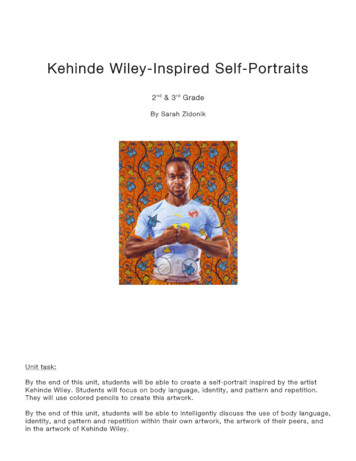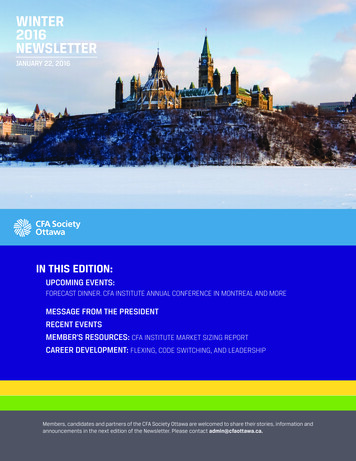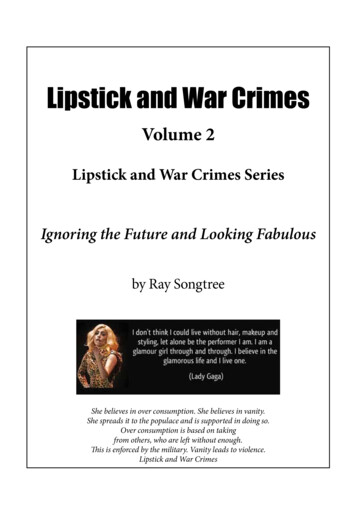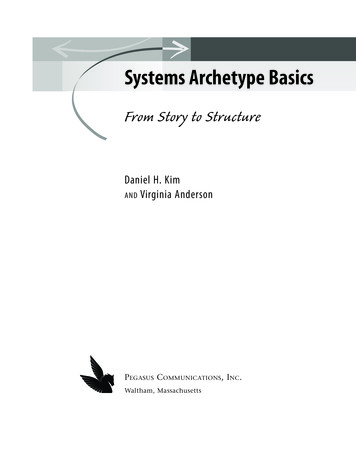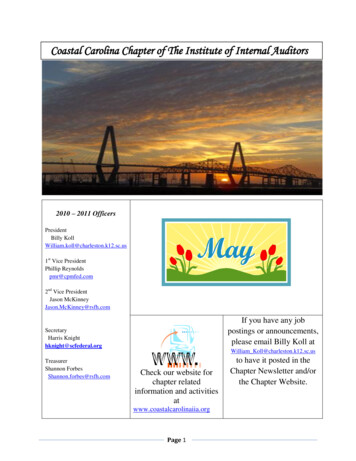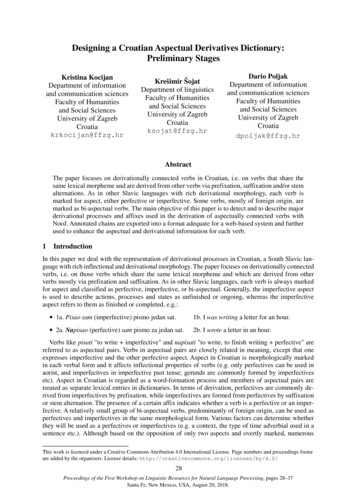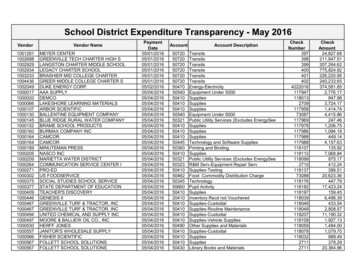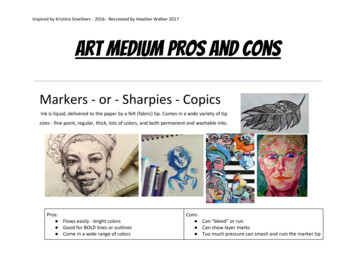
Transcription
Inspired by Kristina Smethers - 2016 - Recreated by Heather Walker 2017Art Medium Pros and ConsMarkers - or - Sharpies - CopicsInk is liquid, delivered to the paper by a felt (fabric) tip. Comes in a wide variety of tipsizes - fine point, regular, thick, lots of colors, and both permanent and washable inks.Pros: Flows easily - bright colors Good for BOLD lines or outlines Come in a wide range of colorsCons: Can “bleed” or run Can show layer marks Too much pressure can smash and ruin the marker tip
Depending on the tip of the point of the pen, can beused for fine lines and precise drawing and textures Line thickness varies with pressure Can layer or blend or mix colors Colors become darker or more saturated with layers Good for Stippling technique Cannot erase Hard to achieve smooth blending / transitions Can be very basic (Crayola) or very expensive (Copic)Watercolor PaintPainting using translucent (see-through) pigments suspended in water. May come in dry pigment trays, or tubes of (thick) liquid.Pros: Semi-translucent paint Can be remoistened and altered after they dry on thepage. (Brought back to life) Have a wide variety of techniques to create texturaleffects Balance of pigments and water - Not too much ofCons: Must wait to dry between layers if you want color todarken. (Requires patience) Work best on watercolor paper. (thicker paper) It is best to tape down paper to combat warping. Can be difficult build up color if not using propertechniques.
water Easy to blend / create color transitions Work from light to dark in layers - don’t use white Can come in colored watercolor pencil form. Don’t use white paint - use the white of the paper.Pencil (Graphite) Drawing/shading pencils. Good for sketching out ideas no matter what medium you want to use. Good for developing a range of grayscale (white to black) values for shading.Pros: Graphite is fairly easy to control. Can be mechanical or traditional pencil Draw light until it’s right.Cons: Can smudge easily if not careful Can be hard to erase if you don’t control pressure. Metallic color never fully black.
Can coat with spray fix (to prevent smudges whenfinished) Can create a wide range of values and textures Directional mark making is VERY important to create3D effect. Can be sharpened by hand or sharpener.Colored Pencil Pencils of compressed pigments held together with wax. Cheaper ones have more wax less pigment(Crayola) more expensive have less wax more pigment. (Prismacolor)Pros: Come in a wide variety of colors.Work best when layers of different colors are built up overtime, rather than a single color used heavily.Can layer and mix colors.Easy to use for fine detail or large areas.Can create rich, textural layers of color as well as verysmooth, refined shading- it depends on the techniqueCan purchase colorless blender pencils to help blendCons: If used with too much pressure will not take any morecolor or allow for more layering. Do not erase fully. To create depth and realistic color must do layeringand vary pressure - most people want to just use onecolor and press harder or lighter - this will not resultin realistic colors or depth. Have soft cores that can break easily if dropped.
colors - white can sometimes do this as wellWorks well on colored (toned) paperDirectional mark making is very important to create 3Deffect / realistic shading.Can be contained in wood like a pencil or woodless andlike small sticks of solid color. Need to be sharpened often and by hand.Oil Pastel Resembling a large crayon, oil pastels have a thick, creamy texture and can be spread and some can be blended with a wetpaintbrush (like a watercolor pencil).Pros: Like a large crayon, oil pastels have a thick, creamytexture and can be spread and some can be blendedwith a wet paintbrush (like a watercolor pencil). Available in a wide range of colors Easy to blend, layer and create textures with Can mix colors Rich and bright colors Easy to fill in large areas quicklyCons: Challenging to get fine detail - need to use blendingstick - blending stick must be sharpened withsandpaper. Easy to smudge and blend which can get messy Can be fragile - easily broken Need to be cleaned with paper towel after layeringon other oil pastels - they pick up other colors Do not erase.
Can work well on colored (toned) paper Work well with blending sticksChalk Pastel Compressed, dry pigments usually in a rectangular or cylindrical stick- powdery and relatively soft, similar to charcoal. Never blow on pastels to remove dust - it puts the particles into the air which can get into your eyes or lungs, neither ofwhich is good for you. Instead, GENTLY tap your work against the table surface to get rid of excess pigment, and wipe up themess at the end of class.Pros: Bright and available in a wide range of colorsEasy to blend, layer or mixWork very well on colored (toned) paperWork well with a blending stick.Cons: Messy / powderyEasily smudgedFine dust created when usedCannot totally be erased
Easy to fill large areas quickly. Able to create many textures with. Must be sprayed with fixative to fix colors in place. Challenging to create fine detail Need to be cleaned after mixing with a paper towel.Charcoal A very loose, powdery medium made (traditionally) of charred wood. It comes in two colors, black and white. Never blow on charcoal to remove dust - it puts the particles into the air which can get into your eyes or lungs, neither of which is goodfor you. Instead, GENTLY tap your work against the table surface to get rid of excess pigment, and wipe up the mess at the end of class.Pros: Easy to blend and create detail Comes in two colors black and white Great for contrast, shadows, highlights, and shading(value) Can produce very light or very dark marks - all aboutpressure Works well on black or colored (toned) paper.Cons: Smudges easilyProduces a dust / fine powderNeeds to be hand sharpenedVery soft and can be easily broken if droppedCan not fully eraseMust be spray fixed to fix charcoal into place toprevent smudging when finished.
Comes in pencil, stick, and vine forms.Easy to lighten with eraserWorks well with a blending stickDirectional mark making very important to creating3D effect / form / depth.Tempera Paint A liquid paint that is typically semi-opaque (not see through). Once tempera dries, it can be remoistened. Can be used similar to watercolor but color is more vibrant or bright. Chalky once dried.Pros: Semi-opaque paint Can be remoistened and altered after they dry on thepage. (Brought back to life using water.) Have a wide variety of techniques to create texturaleffects Easy to blend / create color transitions Can layer easily.Cons: Must work quickly to blend colors before paint dries. It is best to tape down paper to combat warping. Can be difficult build up color if not using propertechniques. Some people don’t like the chalky consistency it driesto Some colors mix inconsistently because of thepigments used.
Cheaper kind of paintIndia Ink A liquid ink (typically black in color) that becomes permanent when dry, that typically comes in bottles, allowing you to use itfor a variety of purposes, with either brushes or pens (calligraphy) and tips of pens (nibs). Pens have a variety of tips (nibs) that can be changed out of the nib holder. They range from being able to create very finelines to creating very broad, thick lines (good for calligraphy).Pros: Can be applied with a variety of pen tips designed to bedipped into ink and can also be used like paint, withbrushes. Good for creating textural drawings with intentional,Cons: Cannot erase at all!(Draw your idea in lightly in pencil first!) Will stain clothing. Takes skill and planning to control.
clear marks - lots of contrast Can be thinned with water while still liquid to createlighter tones/values. Brushes are soft and flexible and typically round, not flatand come in a variety of sizes. Great way to create a value painting May work in layers like watercolor but does not comeback to life with water.Ink Pens - Ballpoint Pen - Gel Pens Ink, generally thick and gel-like, that is applied to paper with a small, rolling metal ball atthe tip of the pen. Traditionally black and blue, but now comes in a wide variety of colors - especially gelpens.Pros: These are fairly easy to control, will typically not “bleed” good for fine mark-making and detail Easy to create texture.Cons: Most are NOT permanent ink. Does not erase. Can smudge if built up thick or sometimes drop out blots
Can be used to create value by layering (usually hatching& cross-hatching or stippling) Can vary line thickness and darkness with carefulchanges in pressure.of ink.Acrylic Paint A thick, liquid paint that is typically semi-opaque (not see through). These paints are water soluble while still wet (meaning the pigment can be washed out using water), but are water-resistantwhen dry. This is especially important to keep in mind when caring for paint brushes- acrylic paint left to dry in a paintbrushwill forever ruin that paintbrush.Pros: Comes in a variety of colors. Easy to mix and create your own colors Able to be blended, layered and create a variety oftexturesCons: Once dried cannot be remoistened or reworkedhowever you can repaint on top. Dries fairly quickly if applied in thin layers which canmake blending challenging.
Many different techniques and styles of painting.Can be applied thickly to create texture - (impasto)Styles vary from realistic to abstract.Takes a lot of practice to get used toTo create depth - mix colors with darker colors avoidlarge quantities of black - use purple or blue Can show brush strokes or be blended smoothly Can use paint brushes, fingers, or pallet knives to paint Takes lots of practice, patience and persistence. Best to plan out your painting in pencil first. Acrylic paint left to dry in a paintbrush will forever ruinthat paintbrush- MUST CLEAN WELL.Mixed MediaPros: Any and all art mediums can be combined with one another to createinteresting effects, textures and looks. No rules - pick your favorite mediums and try to combine them together Often include collaging materials together or cutting out papers. Lots of experimentation leads to new discoveryCons: Can be messy Some mediums don’t layer welltogether. Can be frustrating but just takes
Can use even “non art” materials - leaves, string, cardboard etc. Can even involve embroidery or sewing onto and through the art. Lots of examples online.practice.PrintmakingPros:Cons: Once you carve something away you cannot put it Can usually make copies of your prints - multiples are calledback.editions Have to think in solid colors there is not really You can use anything to make a print, linoleum, wood,shading or it is not done easily.string, cardboard, bubble wrap, plastic wrap, bark, fruit, and Words must be carved backwards, anything youso much more.carve will print in a mirror or reversed way.
Has a very graphic / design look to it. Can be layered and use multiple printing blocks on top ofone another to create a layered print image. Lots of clean up / proper care and maintenance oftools.Supplies You Need & Clean Up NotesMarkers / Sharpies-Make sure all lids get back on markers tightly.If you borrow Mrs. Walker’s colored sharpies - please return them to her.If a marker dries out - please let Mrs. Walker know before throwing it away.If you want fine tip or regular black sharpies - ask Mrs. Walker they are stored away.Place extra paper under your drawing paper so it doesn’t bleed through on to desk.Watercolor Paint-Supplies you need: set of watercolor paints, paint brushes, cup of water, paper towels, test paper.If you are just testing you do not need to tape down your paper - if it is your project you need to see ask about taping itdown.You are responsible for cleaning paint brushes and supplies.You may mix your watercolors in the lid of the set - wipe the lid clean when finished with your paper towels - clean brushbetween colors - check to see if its clean on your paper towel.Mrs. Walker may allow you to “check out a set” and store it in your cabinet if you decide to use it.Watercolors look best when you mix your own colors - don’t rely on colors straight out of the dish.Pencil / Graphite-Supplies you need: Pencil traditional or mechanical or both!, paper, blending stick (optional), eraserDraw light until it’s right!!!If you want to try some “artist pencils” ask Mrs. Walker (she has a higher quality set stored away)If you use a blending stick please return it - also make sure you sharpen it with the sandpaper - ask if you don’t know how.
Colored Pencil-Supplies you need: Colored pencils - a variety of colors - and paper.NEW colored pencils are sorted according to color and the pencil shape is a rounded triangle - please make sure these end upback in the drawer - they are higher qualityIf you want to try other higher quality sets ask Mrs. Walker she keeps them stored away.More colored pencils that have even more color variety and are in the drawer next to sink at back of room.Sharpen with small hand sharpeners over garbage- DO NOT SHARPEN in the wall pencil sharpener Careful not to drop them - the lead will break.Oil Pastel-Supplies you need: oil pastels, paper towels, blending stick (optional), paintbrush and water (optional), colored (toned) paper(optional), extra paper to cover art project prevent smudging.Oil pastels are sorted by color in plastic bags - please make sure they end up back where they belong.If you need to peel back the wrapper that is okay - but please make sure it ends up in the garbage.If you use a blending stick - make sure you sharpen it to clean off the oil pastel - ask if you don’t know how.Use the paper towel to clean off the tips of the oil pastels after using them to blend and layer over other colors.If you are out of a color - ask Mrs. Walker - she has more stored away.Be careful not to drop them.Chalk Pastel-Supplies you need: chalk pastels, paper towels, blending stick (optional), extra paper to cover art project to preventsmudging, colored (toned) paper (optional)Chalk pastels are sorted by color in plastic bags - please make sure they end up back where they belong.DO NOT blow chalk dust into the air - instead tap the edge of your paper gently on your desk and wipe up extra dust at endof class with a damp paper towel.If you use a blending stick - make sure you sharpen it to clean off the chalk pastel.Use the paper towel to clean off the tips of the chalk pastels after using them to blend and layer over other colors.
-If you are out of a color - ask Mrs. Walker - she has more stored away.Be careful not to drop them.Charcoal-Supplies you need: charcoal pencils - black and white - extra paper to cover art proejct to prevent smudging, blending stick(optional) - vine charcoal (optional) - stick charcoal (optional) - colored (toned) paper (optional)DO NOT blow dust into the air - instead tap the edge of your paper gently on your desk and wipe up extra dust at end ofclass.Sharpen with small hand sharpeners over garbage- DO NOT SHARPEN in pencil sharpener Careful not to drop them - the lead will break.Tempera Paint-Supplies you need: clear paint pallet, paint brushes, cup of water, paper towels, test paper.If you are just testing you do not need to tape down your painting - if it is your project you need to see me about taping itdown.Make sure the lids get snapped back onto the paint bottles and are not messy!You are responsible for cleaning paint brushes and supplies.You may mix your tempera paint in the paint pallet - clean brush between colors - check brush on paper towelYou may be able to keep your mixed pallet in your cabinet if you need to.Tempera looks best when you mix your own colors - don’t rely on colors straight out of the bottle.India Ink-Supplies you need: Jar of ink, sumi paint brushes, calligraphy pen and nibs (optional), cup of water, paper towels, test paperIf you are just testing you do not need to tape down your painting - if it is your project you need to see me about taping itdown.You are responsible for cleaning paint brushes and supplies. - Clean ink pen nibs with water!When you take off the lid to the jar of ink lay it on a paper towel - dip your brush into the ink - wipe the brush on the sides ofthe jar to get off extra ink - YOU DO NOT NEED A LOT -Ballpoint Pen or Gel Pen
-Supplies you need: Pens (black or blue) or other colors, paper.Mrs. Walker does not have any gel pens - feel free to bring in your own.Acrylic Paint-Supplies you need: white paint pallet, paint brushes, cup of water, paper towels, test paper.If you are just testing you do not need to tape down your painting - if it is your project you need to see me about taping it down.You are responsible for cleaning paint brushes and supplies.Make sure the lids get snapped back onto the paint bottles and are not messy!You may mix your acrylic paint in the paint pallet - clean brush between colors - check brush on paper towelYou may keep your mixed pallet in your cabinet if you need to - you have to wrap up it up specially - ask Mrs. Walker for helpAcrylic looks best when you mix your own colors - don’t rely on colors straight out of the bottle.Printmaking-Supplies you need: Printing ink, linoleum or a printing block of some sort (cardboard, etc.), glass fo rolling ink, brayers/rollers. You mayneed carving tools if you are using linoleum.If you are just testing you do not need to tape down your paper- if it is your project you need to see me about taping it down.You are responsible for cleaning all supplies - brayers/rollers, ink glass.Make sure the lids get screwed back on printing ink.You are responsible for putting all supplies away.It may be helpful to use multiple pieces of paper then collage prints together.Mixed Media-Supplies you need: you can use any of the above supplies for mixed media make sure you follow the proper instructions for whatevermedia you combine. There is also a collage paper box feel free to rip out of these magazines or use scissors to cut.If you are just testing you do not need to tape down your paper- if it is your project you need to see me about taping it down if you areusing wet media like paint.You are responsible for cleaning paint brushes and supplies.Make sure the lids get snapped back onto the paint bottles and are not messy!You are responsible for putting all supplies away.Be aware that not all mediums will mix well together it may be helpful to use multiple pieces of paper then collage them together.If a supply gets “ruined” like using a sharpie on top of oil pastel please let Mrs. Walker know.
Ink Pens - Ballpoint Pen - Gel Pens Ink, generally thick and gel-like, that is applied to paper with a small, rolling metal ball at the tip of the pen. Traditionally black and blue, but now comes in a wi
